Work and Energy
NCERT-CBSE-Class-9-Science-Chapter-10
Notes
|
Topics to be learn :
|
In everyday life, the word work is used to represent a physical or mental activity involving some effort.
Examples:
- A person climbing a staircase with a bag in his hand.
- A student reading a book.
Work :
Work is said to be done, when an object is displaced from its position by applying a force. Object is always displaced in the direction of net force.
Not Much ‘Work’ in Spite of Working Hard! :
- The phrase "Not much ‘work’ in spite of working hard" highlights an important distinction between the everyday use of the word work and its technical meaning in science.
- If there’s no displacement in the direction of the force, no work is done—according to science.
Example:
Pushing a wall with full effort for 10 minutes but the wall doesn’t move.
- Force is applied.
- Displacement = 0.
- Therefore, Work = 0 joules, even though you're sweating and exhausted.
Scientific Conception of Work
From the point of view of science, following two conditions need to be satisfied for work
- A force should act on an object.
- The object must be displaced.
If any one of the above conditions does not exist, work is not done.
Example : A girl pulls a trolley and the trolley moves through a distance. In this way, she has exerted a force on the trolley and it is displaced. Hence, the work is done.
Work Done by a Constant Force :
Work done by a force on an object is equal to the magnitude of the force multiplied by the distance moved in the direction of force.
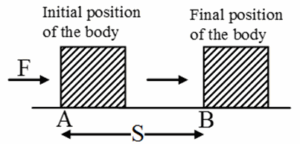
Let us assume that a constant force F acts on an object at point A (shown in the figure), due to which the object gets displaced through a distance s in the direction of the force and reaches at point B, then the work done (W) by force (F) on that object will be equal to the product of the force and displacement.
Work done = Force x Displacement in the direction of force
i.e. W = F x s ... (i)
SI Unit of Work :
- The SI unit of work is Newton−metre (N−m) which is also called Joule (J).
- If F = 1N and s = 1m, then the work done by the force will be 1 N−m or 1J.
- Thus, 1 J is the amount of work done on an object when a force of 1 N displaces it by 1 m along the direction of net force.
- 1 Joule = 1 Newton x 1 metre => 1 J = 1 N−m
- Work is a scalar quantity, it has only magnitude and no direction.
Example : A force of 5 N is acting on an object. The object is displaced through 2 m in the direction of the force (Fig.). Calculate work done.
![]()
Given : Force F = 5 N, Displacement s = 2 m
Then work done = F x s = 5 N × 2 m = 10 N m or 10 J.
Positive, negative and zero work :
Positive work : When the force acting on the body and the displacement of the body have the same direction the work done by the force is positive.
- Example : When a worker climbs a staircase with some load on his head, the work done on the load by the force applied by the worker is positive.
Negative work : When the force and displacement have opposite directions. The work done is negative.
- Example : When a cyclist applies brakes to his bicycle and stops it or slows it down, the work done by the applied force is negative.
Zero work : If the displacement of the body is zero or if the displacement of the body is perpendicular to the force, or if there is no net force acting on the body, the work done is zero.
- Example : If a force applied on a big stone lying on the ground does not displace the stone, the work done by the force is zero.
- As in uniform circular motion where the force is always towards the centre of the circle and the displacement is always tangential therefore work done is zero in uniform circular motion.
Example : Let F = constant force acting on a body, s= displacement of the body and q = angle between F and s. (Fig.)
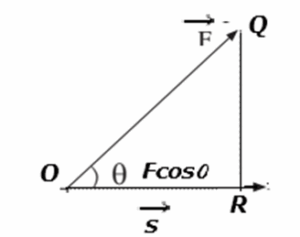
Now, cos θ = OR/OQ
OR = OQ cos θ = F cos θ
This is the component of the force in the direction of the displacement.
\ Work done by the force, W = Force x displacement = (F cos θ)s = Fs cos θ
| θ | cos θ | W = F s cos θ | Conclusion |
| 0° | 1 | W = F s | Work done is positive. |
| 90° | 0 | 0 | Work done is zero. |
| 180° | −1 | W = −F s | Work done is negative. |
- θ = 0° : In this case, the work done by the force is positive and maximum because the force and the displacement have the same direction.
- θ = 90° : In this case, the work done is zero because the displacement is perpendicular to the force.
- θ = 180° : In this case, the work done is negative and minimum as the displacement is in the direction opposite to that of the force.
Note : When a body moves along a circular path, the angle between the force (along radius of circle) and the direction of motion (along tangent of circle) is 90°. Hence, no work is done by a body along circular path.
Energy :
It is the ability to do work. It is always essential for performing any mechanical work.
- The energy of an object is measured in terms of its capacity of doing work.
- The SI unit of energy is same as that of work, i.e. Joule (J).
- 1 joule of energy is required to do 1 J of work. A larger unit of energy is kJ.
Forms of Energy :
Energy exists in various forms like mechanical energy (the sum of potential energy and kinetic energy), heat energy, chemical energy, electrical energy and light energy.
Kinetic Energy :
The energy which is possessed by an object due to its motion is called kinetic energy. Its SI unit is joule (J).
Kinetic energy of a body moving with certain velocity is equal to the work done on it to make it acquire that velocity. Kinetic energy of an object increases with its speed.
Examples of kinetic energy :
- Due to kinetic energy, a bullet fired from a gun can pierce a target.
- A moving hammer, drives a nail into the wood. Due to its motion, it has kinetic energy or ability to do work.
- A running horse has kinetic energy.
- A flowing river possesses kinetic energy.
The kinetic energy possessed by an object of mass m, moving with a uniform velocity v is given by,
KE(or E) = \(\frac{1}{2}\)mv2
Expression for kinetic energy :
Consider a body of mass m moving with a uniform acceleration a along a straight line. If u is the initial velocity of the body, v is the final velocity and s is the distance covered by the body during this change of velocity,

we have,
v2 = u2 + 2as (the kinematical equation of motion)
∴ v2 − u2 = 2as
∴ s = \(\frac{v^2-u^2}{2a}\) …….(1)
If F is the net force acting on the body and W is the Work done by the force,
W = Fs ……(2)
Now, F= ma ……(3)
From Eqs. (1), (2) and (3), We get,
W = ma x \(\frac{v^2-u^2}{2a}\) = \(\frac{1}{2}\)m(v2 − u2)
For a body initially at rest, u = 0
∴ W = \(\frac{1}{2}\)mv2
Work done on a body = change in the kinetic energy of the body.
∴ Kinetic energy of the body = \(\frac{1}{2}\)mv2
∴ The kinetic energy of a body of mass m, moving with velocity v is \(\frac{1}{2}\)mv2
Kinetic energy cannot be negative. The mass (m) of a body cannot be negative. Also, the square of velocity (v2) cannot be negative. Hence, kinetic energy cannot be negative.
Some important results can be derived from the formula KE = \(\frac{1}{2}\)mv2, these are given below :
- If the mass of an object is doubled, its kinetic energy also gets doubled.
- If the mass of an object is halved, its kinetic energy also gets halved.
- If the speed of an object is doubled, its kinetic energy becomes four times.
- If the speed of an object is halved, its kinetic energy becomes one−fourth.
- Heavy objects moving with high speed have more kinetic energy than small objects moving with same speed.
Potential Energy :
- The energy possessed by a body due to its change in position or shape is called potential energy. Its SI unit is joule (J).
- We can say that, the potential energy possessed by a body is the energy present in it by virtue of its position or configuration, e.g. a stretched rubber band, spring, string on the bow, etc.
- Now, we can say that a body possesses energy even when it is not in motion.
Examples of potential energy :
- Water stored in dam has potential energy due to its position at the height.
- A stone lying on the roof of the building has potential energy due to its height.
- A wound spring of a watch has potential energy due to change in its shape.
Potential Energy of an Object at a Height :
- When an object is raised through a certain height above the ground, its energy increases. This is because work is done on it against gravity while it is being raised.
- The energy present in such an object is the gravitational potential energy.
- The gravitational potential energy of an object at a point above the ground is defined as the work done in raising it from the ground to that point against gravity.
Expression for Potential Energy :
Consider an object of mass m, lying at a point A on the Earth's surface. Here, its potential energy is zero and its weight mg acts vertically downwards.
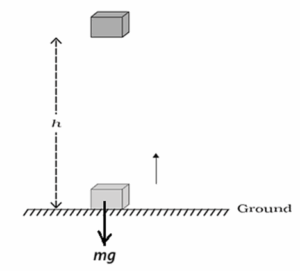
To lift the object to another position B at a height h, we have to apply a minimum force which is equal to mg in the upward direction. So, work is done on the body against the force of gravity. Therefore,
Work done = Force x Displacement
i.e. W = F x s
As, F = mg ……[weight of the body]
Here, s = h
Therefore, W = mg x h= mgh
PE = mgh
This work done is equal to the gain in energy of the body.
This is the potential energy (PE) of the body.
∴ PE(or Ep) = mgh
The potential energy of an object at a height depends on the ground level or the zero level we choose.
An object in a given position can have a certain potential energy with respect to one level and a different value of potential energy with respect to another level.
The work done by gravity depends on the difference in vertical heights of the initial and final positions of the objects and not on the path along which the object is moved. It is clear from the figure given below.
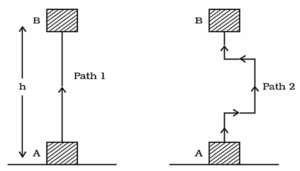
In both the above situations, the work done on the object is mgh.
Are Various Energy Forms Interconvertible?
Energy can be transformed from one type to another.
Different forms of energy : Mechanical energy (potential energy and kinetic energy), heat, light, sound, electrical energy, solar energy, chemical energy, nuclear energy, etc., are different forms of energy. Energy can be converted from one form to another.
- Chemical energy : The energy released from chemical reactions is called chemical energy.
- Nuclear energy : The energy released when heavy unstable atomic nuclei break up (fission) as well as the energy released when light elements combine to form a heavier element (fusion) is called nuclear energy. Nuclear energy can be converted into electrical energy.
- Solar energy is the energy radiated by the sun. It is in the form of heat, light, radio waves and other radiations. Solar energy can be converted into electrical energy. Plants use solar energy for photosynthesis.
- Heat energy needed to cook food is obtained by burning wood or biogas or LPG or using electricity or solar energy.
Law of Conservation of Energy :
The law of conservation of energy states that energy can neither be created nor be destroyed, it can only be transformed from one form to another.
The total energy before and after transformation always remains constant.
Free fall:
Free fall: An object falling solely under the influence of the gravitational force acting on it due to the earth is said to be in free fall or to be falling freely. Here, the effects of air (buoyancy and friction) are ignored.
Conservation of Energy During the Free Fall of a Body :
The total energy (potential energy + kinetic energy) of a freely falling body remains constant during its motion.
Proof :
Consider a body of mass m initially at rest at point A at a height h from the ground (Fig.). Suppose that the body is released so that it follows the downward path ABC freely (i.e., the buoyancy due to air and air resistance are ignored).
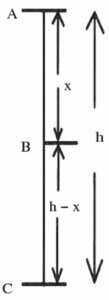
(1) At A
u (initial velocity) = 0
∴ Kinetic energy (KE) = is \(\frac{1}{2}\)mu2 = 0
Potential energy (PE) = mgh, where g is the acceleration due to gravity.
Total energy = 0 + mgh = mgh
(2) At B
If v1 is the velocity of the body at B after covering a distance x,
v12 = u2 + 2gx = 2gx ….(‘,' u = 0)
KE = \(\frac{1}{2}\)mv12
= \(\frac{1}{2}\)m(2gx) = mgx
PE = mg(h − x) = mgh − mgx
Total energy = mgx + mgh − mgx = mgh
(3) At C
If v is the velocity of the body at C, v2 = u2 + 2gh (considering the motion from A to C)
v2 = 2gh ….('.' u = 0)
KE = \(\frac{1}{2}\)mv2
= \(\frac{1}{2}\)m(2gh) = mgh
PE = 0 at the ground level
Total energy = mgh + 0 = mgh
Thus, the total energy of the body is the same at points A, B and C, i.e., the total energy remains constant during the motion of the body.
Conclusion : Every object has potential energy when it is at a height above the ground and it keeps getting converted to kinetic energy as the object falls towards the ground. On reaching the ground (point C), all the potential energy gets converted to kinetic energy. But at any point during the fall the total energy remains constant.
i.e., T.E. = P.E. + K.E.
T.E. at A = mgh + 0 = mgh
T.E. at B = mgx + mg (h − x) = mgh
T.E. at C = 0 + mgh = mgh
The sum of kinetic energy and potential energy of an object is also called mechanical energy.
We observe that, during the free fall of an object, the decrease in potential energy at any point in its path appears as an equal amount of increase in kinetic energy.
Thus, we can say that, there is a continuous transformation of gravitational potential energy into kinetic energy.
Examples : How various forms of energy are interchangeable :
- When an object is dropped from some height, its potential energy continuously converts into kinetic energy. When an object is thrown upwards, its kinetic energy continuously converts into potential energy.
- Water stored in a dam possesses potential energy. When water falls, this potential energy is converted into kinetic energy. In a hydroelectric power station, the kinetic energy of water is used to drive turbines. The turbines are connected to electric generators. Hence, electrical energy is produced.
- While charging a battery, electrical energy is converted into chemical energy. This chemical energy is stored in the battery. When the battery is connected in an electrical circuit, the chemical energy is converted into electrical energy and hence a current flow in the circuit.
- Green plants prepare their own food (stored in the form of chemical energy) by using solar energy through the process of photosynthesis.
- When we throw a ball, the muscular energy which is stored in our body, gets converted into kinetic energy of the ball.
- The wound spring in the toy car possesses potential energy. As the spring is released, its potential energy changes into kinetic energy due to which, toy car moves.
- In a stretched bow, potential energy is stored. As it is released, the potential energy of the stretched bow gets converted into the kinetic energy of arrow which moves in the forward direction with large velocity.
Rate of doing Work :
Power : Power is the time rate at which work is done.
- If W is the work done in time t, power (P) is given by P = W/t,
- It is a scalar quantity.
- The SI unit of power is the watt (W) and CGS unit is the erg per second.
If a device (or an appliance) does work at the rate of 1 joule per second, the power of the device is said to be 1 watt.
1 watt = 1 joule per second
= 107 ergs per second ………… (1 joule = 107 ergs)
Power is also measured in unit horsepower (used in industry).
1 horsepower (hp) = 746 watts
The kilowatt−hour is a unit of energy used for commercial purpose.
1000 joule work performed in 1 second is 1 kilowatt power.
1 kW h = 1 kW x 1hr
= 1000 W x 3600 s
= 3600000 J
∴ 1 kilowatt−hour (KW.h) = 3.6 x 106 J
The electrical energy used in house, industry, commercial establishment, etc., is expressed in kW.h.
Average Power : It is defined as the ratio of total work done by the total time taken.
An agent may perform work at different rates at different intervals of time. In such situation, average power is considered by dividing the total energy consumed by the total time taken.
∴ Average power = \(\frac{\text{Total energy consumed}}{\text{Total time taken}}\)
Click on below link to get PDF from store :
PDF : NCERT-Class-9-Science-Chapter-10-Work and Energy - Notes
PDF : NCERT-Class-9-Science-Chapter-10-Work and Energy - Solution
Main Page : NCERT-Class-9-Science – All chapters notes, solutions, videos, test, pdf.
Previous Chapter : Chapter-9-GRAVITATION – Online Notes
Next Chapter : Chapter-11- SOUND – Online Notes
